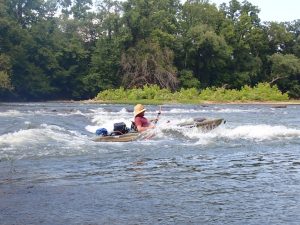
Most scholars of the American Revolutionary War believe the war for independence was won in the South. However, one of the most neglected episodes of the war was The Crossing of the Dan, just west of South Boston in Halifax County, Virginia. In the past few decades, historians have begun to recognize this as a critical moment in the war, so much so that the events have been labeled a turning point in the American Revolution. What happened during the crossing of the Dan, and why is it considered to be so important?
Greene’s Gamble
General Cornwallis had defeated the South Army of the American Revolution in South Carolina. Following this defeat, General Nathanael Greene was appointed commander of the southern troops. With only about 800 men capable of fighting, Greene’s men were outnumbered – another conflict with Cornwallis’s men would be fatal. Such an encounter would give the British control of the Carolinas and Georgia, allowing Cornwallis and his men to march freely into Virginia. Furthermore, Cornwallis’s forces, combined with Benedict Arnold’s men, would likely prove disastrous for Baron Von Steuben’s militia in Virginia.
Realizing he could not confront Cornwallis head-on, Greene devised a series of maneuvers to avoid battle until his men could be reinforced and reequipped. These maneuvers had a second goal: to lure the British away from their supplies and wear them down. He split his army into two forces and utilized guerilla warfare tactics to achieve this.
The Race to the Dan
Half of Greene’s men, under the command of Daniel Morgan, fought Cornwallis’s light corps (under the direction of Lieutenant Tarleton) at Cowpens, South Carolina. The light corps were decimated, with 90 percent of killed, injured, or captured. This defeat enraged Cornwallis, who vowed to free his captured men and destroy the Southern Army, no matter the cost. Cornwallis burned his personal belongings, his army’s supply wagons, and his soldiers’ daily rations in an attempt to move faster in the pursuit of the South Army. The Race to the Dan was on.
Anticipating crossing the Dan River, Greene dispatched two men to prepare – Kosciuszko to build earthworks that would provide defense and Carrington to collect boats to cross the river. Carrington secured the cooperation of Halifax residents, securing all available boats to move the army across the river.
Greene split his army again, sending 700 men to Dix’s Ferry (Danville, VA) as a decoy, while the slower moving army, with artillery and supply wagons, took a shorter route to the Dan River in what is now South Boston. On February 14, 1781, they crossed the swollen river at Boyd’s Ferry (South Boston) and Irvin’s Ferry (3 miles west of Boyd’s). The British arrived as the last of the Americans were crossing the river. With no boats to ferry across, the British were stuck on the southern banks of the river. The Americans had won the Race to the Dan.
A Pivotal Shift
Greene and his men spent a week resting north of the Dan River at the Old Halifax Court House (in present-day Crystal Hill) while planning his next move. His troops were reinforced, and their supplies replenished. On the other hand, Cornwallis’s men were exhausted from their unsuccessful pursuit, further exacerbated by a lack of supplies and rations. Greene now had an advantage over the British forces.
Over the next month, the British retreated to Guilford Court House (Greensboro, NC) facing ambushes and clashes with Americans along the way. Finally, the Southern Army confronted Cornwallis head-on at the Battle of Guilford Courthouse, where Americans outnumbered the British. Though Cornwallis held the field, it was at a significant cost.
The Aftermath and Lasting Impact
Cornwallis’s vow to destroy the Southern Army at any cost had ended in complete failure. In just three and a half months, Cornwallis and Tarleton had been responsible for losing nearly half their troops. From there, he took his army to Wilmington, NC, to wait for reinforcements and supplies. At the same time, Americans fought to capture British posts that remained across the Carolinas, furthering their advantage.
Thanks to the tactical prowess of General Nathanael Greene, the Race to the Dan had been won. The rest he and his men afforded in Halifax County, in addition to supplies and reinforcements, gave him and his troops the advantage, one Cornwallis could never overcome. Every February, locals and historians gather at the location on the Dan River in South Boston to commemorate the actions of Nathanael Greene and his men.
Learn more at the South Boston – Halifax County Museum of Fine Arts and History’s permanent Crossing of the Dan exhibit.



